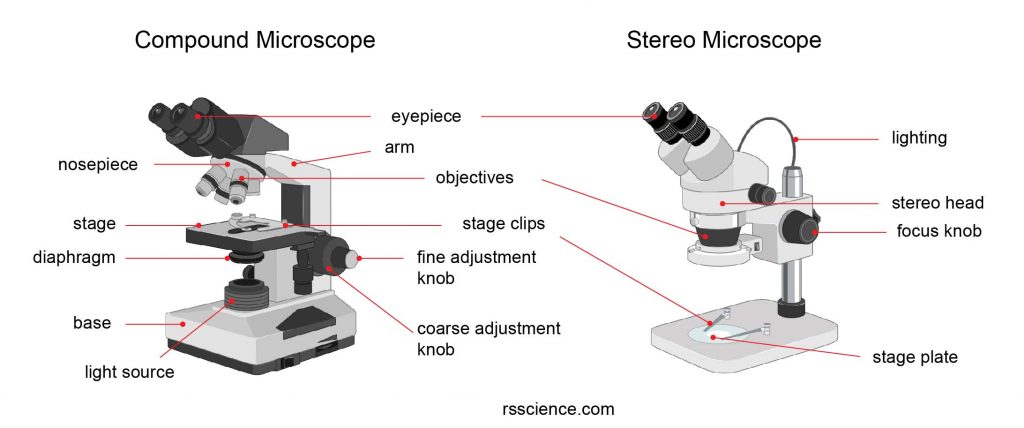Microscopes have long enchanted the world of science, serving as portals to a hidden universe that thrives beneath our naked eyes. With the advent of advanced technology and the burgeoning interest among younger audiences, the dilemma of choosing between a stereo microscope and a compound microscope beckons attention. This decision is crucial, for it can significantly enhance your exploration of the microscopic realm. Let’s dive into the remarkable features of both types and explore how each can ignite your scientific curiosity.
To understand the decision better, we must first dissect the fundamental differences. A compound microscope primarily excels in the realm of high magnification, revealing intricate details typically invisible to the unaided eye. Its complex design includes multiple lenses and a light source that illuminates specimens on slides, allowing for observation of cellular structures, microbial life, and more. In contrast, a stereo microscope offers a low-power, three-dimensional perspective, perfect for viewing larger specimens in their full glory. This unique feature makes it an excellent choice for those interested in dissecting and examining intricate materials like insects or circuit boards.
At first glance, the compound microscope may seem like the more sophisticated choice, bustling with optical technology that delivers astonishing magnification capabilities, often reaching powers of 1000x or more. This allows budding scientists to inspect the minutiae of biological specimens, such as plant cells or bacteria, with exceptional clarity. In laboratories, it’s a go-to instrument for biology enthusiasts, medical students, and professionals alike. The unparalleled detail rendered by a compound microscope can enthrall anyone fascinated by biological intricacies.
Nevertheless, the stereo microscope holds its ground with an entirely different appeal. Focusing on larger, three-dimensional samples, it bestows an unparalleled depth of field. This characteristic is particularly advantageous for those dabbling in fields such as geology, engineering, and horticulture. Imagine examining a gemstone’s facets or investigating the anatomical structure of an insect while retaining the ability to perceive its spatial attributes. The stereo microscope fosters an engaging, immersive experience conducive to hands-on exploration.
The usability of both microscope types varies significantly, catering to different audiences. A compound microscope may necessitate a more patient approach, as users prepare slides, adjust the focus meticulously, and seek the right lighting conditions. It rewards the attentive observer, enhancing a scientific rigor that nurtures deep understanding. Conversely, the stereo microscope is often more forgiving, inviting users to manipulate larger, unprepared specimens directly. This quality fosters an engaging environment where experimentation thrives, much to the delight of novice and seasoned scientists alike.
Another pivotal point in this discussion lies in the educational value each microscope type offers. For younger audiences just embarking on their scientific journeys, a stereo microscope can serve as an attractive entry point. Its straightforward operation can nurture curiosity without overwhelming beginners. Engaging with diverse specimens and observing them in all their natural splendor can instill a sense of wonder and enthusiasm for the scientific process early on, potentially inspiring lifelong exploration.
Conversely, a compound microscope provides an opportunity to delve deeply into the microscopic workings of life. For high school students or budding researchers aiming to embark on academic aspirations in the field of biology or health sciences, mastering the compound microscope cultivates essential laboratory skills. Understanding specimen preparation, stain applications, and cellular observation builds a solid foundation for future scholarly endeavors.
The cost factor also plays a critical role in choosing between these two optical instruments. While both microscopes can fit a range of budgets, entry-level stereo microscopes tend to be more affordable, making them accessible for classrooms and amateur enthusiasts alike. For casual learners or those experimenting on a budget, the stereo microscope can deliver an exciting, tangible learning experience without necessitating a hefty investment. On the other hand, high-quality compound microscopes can demand a greater investment, but they are well worth it for serious students and professionals aiming for precision in their observations.
To conclude, the decision of choosing between a stereo microscope and a compound microscope ultimately depends on your personal interests, desired applications, and level of experience. Both types are invaluable tools that serve unique purposes in the world of science. Whether you yearn to explore the lush vibrancy of biological specimens under a compound microscope or dissect the intricate morphology of larger objects with a stereo microscope, the adventure into microscopy promises to unfold new dimensions of knowledge and inquiry.
The true beauty lies in the choice you make, as each path unveils a myriad of discoveries waiting to be explored. So gear up and choose wisely—your microscopic journey awaits!









Leave a Comment